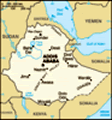Advertisement

 Enduring Orthodoxy
Enduring Orthodoxy
Inside one of Lalibela's rock-hewn churches, a priest displays the 12th century cross...for a fee.Northern Ethiopia is all about living history -- mostly the ancient living history of Orthodox Christianity. We made a big bus loop through the north visiting all the main hitoric sites. The roads are horrific and the buses are hot, slow, and unreliable, but it is well worth the hassle. Here are some of the key stops.
The Islands of Lake Tana Lake Tana is the source of the Blue Nile, and home of the most gargantuan pelicans you've ever seen. The lake is dotted with lush little island peaks, each one with its own ancient monastery. Most have been in active use for the past 5 or 6 centuries. Each island has a tiny community of monks and a priest who keep the place running, study their Ge'ez (Ethiopia's equivalent to Latin), and show tourists around. One of our favorite stops was Ura Kidane, with its massive circular church of mud and straw construction, and exquisitely thatched roof. The earthen materials and tones of the exterior contrast sharply with the vibrant paintings of famous religious scenes that line every square inch of the central chamber. As we wandered within the thick walls, a couple dozen deacons sat peacefully under

 Lake Tana - Treasures of Gabriel Kibran
Lake Tana - Treasures of Gabriel Kibran
A very groovy priest displays an ancient triptych from Gabriel Kibran's massive store of artifacts.a mango tree receiving instruction from the priest. Another monestary, Gabriel Kibran, had the most impressive artifacts, though Sarah was unfortunately banned from entry for her unwillingness to go Yentle. Hurry to this place if you'd like to see the collections of 800+ year old religious texts (written and illustrated on goat skins). The monks drag these out for any old tourist who shows interest, so pretty soon they'll either complete their disintigration, or, less likely, be moved to a museum. (See below for more Lake Tana pictures.)
Gonder Gonder's annual Timkat festival preswented our livliest encounter with Ethiopian history. This ancient ceremony takes place every January, and apparently celebrates the baptism of Christ. We gathered right outside Gonder's Castle complex where generations of Ethiopian kings each built their respective headquarters. From this point, we watched processions emerge from their respective churches and collide into a swirling mass in the central square. Each procession had, at its core, a cadre of stern-looking priests in colorful, velvety garb and matching parasols. They carried elaborate, metal processional crosses in their hands and tablets on their head. The tablets are replicas of the 10 commandments, and if your are a legitimate Ethiopian

 Gonder - Ten Commandments on the Move
Gonder - Ten Commandments on the Move
Some serious priests with some serious velvet cruzing through the streets of Gonder.orthodox church, you gotta have a set. Along with these sober priest pods, each church sent its young smiley drummers and choral members to beat their rhythms and chant their chants. The resultant cacophony was periodically interrupted by marauding bands of the non-church-going young men wielding long sticks, and chanting a more aggressive and percussive mantra. Interspersed among these hundreds of well-organized groups were the thousands of exuberant townsfolk, dressed mostly in gabbis (a layered white cotton fabric wrapped around the shoulders), who spontaneously organized their own chant, cheers, and ululations along the route.
Together, we meandered several kilometers to Fasilades Bath, where for hundreds of years, Ethiopian Orthodox Christians have symbolically baptised themselves on Timkat. Unfortunately, this historic practice was interrupted this year for an Italian-led renovation of the bath complex. But the very permanent-looking makeshift bath nearby seemed to inspire just as much enthusiasm, if the amound of baptismal splashing is any indication. (See below for more Gonder pictures.)
Ancient Axum The northern city of Axum is unusual in Ethiopia, because its historic sites are just that...historic relics of the past. Bat-filled crypts, a field of giant granite obilisks (looking like like 2nd century sky scrapers),

 Axum Stelae Field
Axum Stelae Field
In the distance stands the field of carved granite obelisks, representing
a lot of work, but no one really knows what else. Everyone debates how the Axumites erected these massive granite pillars nearly 2000 years ago.and old palace foundations (including one claimed to be the palace of Queen Sheeba) - all just sitting there with no prominant function in today's Ethiopia.
But like everyplace else in the North, Axim also has its living history. It claims to be home to the Ark of the Covenant (and there's a reasonable case for this, spelled out in great detail in “The Sign and the Seal” by Graham Hancock). Anyway, they wouldn't let us see it, something about my looking too much like Indian Jones.
There's also a modern story to one of the giant granite obelisks (called stelae here). One of the biggest stelae was looted by Mussolini's troops during his occupation of Ethiopia. In April 2005, it was returned from the Piazza di Porta Capenamin in Rome, where it stood for decades. While we were there, it was still in three separate pieces outside the stelae field, waiting to be reassembled.
The best parts of Axum, though, are the "modern" parts - an incredible market; ancient-looking, carefully crafted stone walls of shops, homes, and gardens, being built before our very eyes, often with no morter at all; and an exceedingly slow pace that

 Debra Damo Plateau
Debra Damo Plateau
Debra Damo is built on top of the plateau in the distance. From this side, you can only see the easy way up.forces you to take a deep breath before making the turn to head back south toward Addis Ababa. (See below for more Axum pictures.)
The Sky Island of Debra Damo About 7 kilometers from the much disputed Ethiopia/Eritrea border, far removed from the lush island monastaries of Lake Tana, is an island monastary of a different sort. Set atop a tall, isolated plateau, amidst dry rocky hills, accessible only by a 50 foot rope up a sheer cliff face, is the historic religious center of Debra Damo. While Sarah waited below (women are not allowed), our friend Michael and I climbed the cliff with surprisingly powerful assistance from the lanky monk hoisting up the rope from above. On the plateau, we wandered among the artistic stone monastary buildings, deep caverns filled with "holy water" cut into the rock floor of the plateau, and cliffside grave yards reeking of recent burials. We enjoyed spectacular views of the desolate surroundings, but felt an eerie emptiness from the many abandoned stone houses. Debra Damo is still a place of learning for priests and monks, but no longer the booming religious center of the past. (See below for more Debra Damo pictures.)

 Entering the Rock
Entering the Rock
Can you spot the church entrance? Look below for more pictures from Tigray.
The rock-hewn churches of Tigray are where it's at for combined mountaineering and scenic historic orthodox Christian exploration (a growing niche in adventure tourism). There are dozens of man-made cave churches strewn throughout the region's dramatic cliffs. We visited six of them, each one completely different from the next. Here's the general approach: you walk from some spot in the road where your fellow minibus passengers tell you to get out; you trudge through baren rocky fields with an ever growing hoard of children who believe that the 8,403rd time they ask for money will be their lucky moment; you reward the child who gets the hint after 645th failed begging attempt by designating him as your official guide; and you have him lead you to the appropriate spot along the cliff face (he'll know what you're looking for). At some moment during your approach, you will suddenly spot a door into the mountain. Send your guide to fetch the priest with they key. When the kid tells you the priest is not anywhere around, give him some more money. When they return from the nearby sorghum fields, the priest will unlock the mountain, into which

 Waiting to Pray
Waiting to Pray
This is the entrance to one of the tunnels that link between Lalibela's many churches. See below for more pictures from Lalibela.has been carved an exceedingly atmosperic stone chapel, complete with alter, paintings, frescos, arches, cloisters, etc. Give the priest some money, take some pictures, and hike on. OK, there are some variations to this pattern: sometimes the hike is up to a mountain top, sometimes there is a little entry chappel rather than just a hole in the mountain, sometimes the kids ask for pens instead of money. But every time, the cave is enchanting, cool, quiet, and makes you marvel at the faith and dedication of its builders. (See below for more Tigray pictures.)
The Rock-Hewn Churches of Lalibela In Lalibela, we found more tourists and more eye-juice-loving flies than anyplace in Ethiopia. Despite these distractions, we obligingly dropped our jaws when we saw its 12th century rock-hewn churches. The Lalibelans took a giant step beyond the Tigray-style carved caves described above. As soon as they finished carving ornate columns, arches, alters, and frescos into their cave churches, they proceeded to also carve away the surrounding mountain in order to create an equally ornate exterior. What was left? Entire cathedrals carved from a single chunk of rock. Sound unbelievable? You've got to see it...and then you still can't

 Wild-eyed Children of Harar
Wild-eyed Children of Harar
Just a few of the children running through the narrow streets of Harar. believe it. And the crazy thing...every one of these churches is, to this day, filled with priests, monks, and deacons, studying their ancient texts, swinging their smoldering iron insence holders, jingling their ancient sistra (a sort of 6th century Christian orthodox tamborine), and, of course, posing with their massive metal crosses so that the snap-happy tourist can get the desired digital photos for his blog. (See below for more Lalibela pictures.)
The Walled City of Harar A complelely different history revealed itself in Harar, an ancient walled city in eastern Ethiopia. Harar has 90 different mosques packed into space of only few square kilomters, to support its 90%!m(MISSING)uslim population. We wandered through the well-worn winding stone paths lined by whitewashed walls, stone buildings, and disintegrating balcony overhangs. We walked carefully so as not to trip over the legs of local dudes blissed-out on chat (the leaves of a mildly narcotic local plant). Harar feels like a museum except that all the homes are still occupied, kids are running every which way, and there is fresh sewage flowing in all the gutters. Dozens of mosques call-out prayers simultaneously. In the evening, this cacophany competes with the eerie wails of

 Lake Tana - Sarah between Islands
Lake Tana - Sarah between Islands
Motoring around on the little motor boat we hired. If you look carefully, you can see the top of a monastery peering out the island peak in the background. But creating great views did not seem to be the priority in Lake Tana monastery design a huge lost opportunity.laughing hyenas who roam the city's waste piles for food scraps. (See below for more Harar pictures.)
Advertisement
Tot: 0.164s; Tpl: 0.014s; cc: 11; qc: 86; dbt: 0.0825s; 1; m:domysql w:travelblog (10.17.0.13); sld: 1;
; mem: 1.3mb























Lawrence MacDonald
non-member comment
Wow! What a great set of photos!
This is a great posting that deserves to be widely read and viewed. It makes me think what an incredible tourist bonanza Ethiopia could experience with proper security and improved roads. I had never realized what a wealth of sites and sights there are to be visited. Thank you Sarah and Jonothan for putting together this great report! (I envy your trip!)